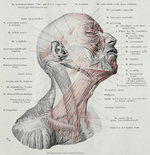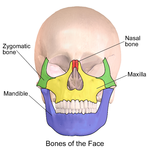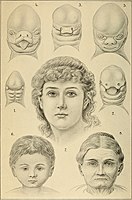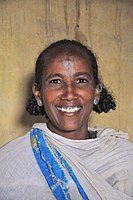Face
This article aboutbiologymay beexcessively human-centric.(March 2024) |
| Face | |
|---|---|
 Face of a woman (left) and face of a man (right) | |
 Ventrolateral aspect of the human face with skin removed, showing muscles of the face | |
| Details | |
| Identifiers | |
| Latin | facies, facia |
| MeSH | D005145 |
| TA98 | A01.1.00.006 |
| TA2 | 112 |
| FMA | 24728 |
| Anatomical terminology | |
Thefaceis the front of an animal's head that features theeyes,noseandmouth,and through which animals express many of theiremotions.[1][2]The face is crucial for humanidentity,and damage such as scarring or developmental deformities may affect the psyche adversely.[1]
Structure
[edit]The front of thehuman headis called the face. It includes several distinct areas,[3]of which the main features are:
- Theforehead,comprising theskinbeneath thehairline,bordered laterally by thetemplesand inferiorly byeyebrowsandears
- Theeyes,sitting in theorbitand protected byeyelidsandeyelashes
- The distinctivehuman noseshape,nostrils,andnasal septum
- Thecheeks,covering themaxillaandmandible(or jaw), the extremity of which is thechin
- Themouth,with the upperlipdivided by thephiltrum,sometimes revealing theteeth
Facialappearanceis vital for humanrecognitionandcommunication.Facial musclesin humans allowexpressionofemotions.[citation needed]
The face is itself a highlysensitiveregion of the human body and its expression may change when thebrainis stimulated by any of the many humansenses,such astouch,temperature,smell,taste,hearing,movement,hunger,orvisual stimuli.[4]
Variability
[edit]The face is the feature which best distinguishes aperson.Specialized regions of thehuman brain,such as thefusiform face area(FFA), enable facial recognition; when these aredamaged,it may be impossible to recognize faces even of intimate family members. The pattern of specific organs, such as the eyes, or of parts of them, is used inbiometric identificationto uniquely identify individuals.
Shape
[edit]The shape of the face is influenced by thebone-structureof theskull,and each face is unique through theanatomical variationpresent in the bones of theviscerocranium(andneurocranium).[1]The bones involved in shaping the face are mainly themaxilla,mandible,nasal boneandzygomatic bone.Also important are varioussoft tissues,such asfat,hairandskin(of which color may vary).[1]
The face changes over time, and features common inchildrenorbabies,such as prominentbuccal fat-padsdisappear over time, their role in the infant being to stabilize the cheeks duringsuckling. While the buccal fat-pads often diminish in size, the prominence of bones increase with age as they grow and develop.[1]
Facial shape – such asfacial symmetry– is an important determinant ofbeauty.
Other characteristics
[edit]Visible variable features of the face other than shapes and proportions include color (paleness,sun tanandgenetic default pigmentation), hair (length,color,loss,graying),wrinkles,[5][6]facial hair (e.g.beards), skin sagging,[6]discolorations[7](dark spots,[6]frecklesandeye circles[6]),pore-variabilities,[8]skin blemishes (pimples,scars,burn marks). Many of these features can also vary over time due toaging,[6][5][7]skin care,nutrition,[9][10][11][12][13][14]theexposome[15](such as harmful substances of the general environment,[11][15]workplace and cosmetics), psychological factors,[11]and behavior (such as smoking,[15]sleep,[11]physical activity andsun damage[5][7][11]).
Mechanisms underlying these include changes related topeptides(notablycollagen),[7][11]inflammation,[11][13]production of various proteins (notablyelastinand otherECM proteins),[13]the structure ofsubcutaneous tissue,[5][7]hormones,[11]fibers (such as elastic fibers or elasticity)[7]and theskin barrier.[15]
The desire of many to look young for their age and/or attractive[6]has led to the establishment of a largecosmetics industry,[5]which is largely concerned withmake-upthat is applied on top of the skin (topically) to temporarily change appearance but it ordermatologyalso developanti-aging products(and related products and procedures) that in some cases affect underlying biology and are partly applied preventively.[12]Facial traits are also used inbiometrics[16][17]and there have been attempts at reproducible quantifications.[7][8]Skinhealth is considered a major factor in humanwell-beingand the perception of health in humans.[12]
Genetics
[edit]Genesare a major factor in the particular appearance of a person's face with the high similarity of faces ofidentical twinsindicating that most of facial variability is determined genetically.[18]
Studies have identified genes and gene regions determining face shape and differences in various facial features. A 2021 study found that a version of a gene associated with lip thickness – possibly selected for due to adaption to cold climate via fat distribution –introgressedfrom ancient humans –Denisovans– into the modern humansNative Americans.[19][20][21]Another study found look-alike humans (doppelgängers) have genetic similarities, sharing genes affecting not only the face but also somephenotypesof physique andbehavior.[22][23]A study identified genes controlling the shape of the nose and chin.[24]Biological databasesmay be used to aggregate and discover associations between facialphenotypesand genes.[25][26]
Function
[edit]Emotional expression
[edit]Faces are essential to expressingemotion,consciously or unconsciously. A frown denotes disapproval; a smile usually means someone is pleased. Being able to read emotion in another's face is "the fundamental basis for empathy and the ability to interpret a person's reactions and predict the probability of ensuing behaviors". One study used the Multimodal Emotion Recognition Test[27]to attempt to determine how to measure emotion. This research aimed at using a measuring device to accomplish what many people do every day: read emotion in a face.[28]
The muscles of the face play a prominent role in the expression of emotion,[1]and vary among different individuals, giving rise to additional diversity in expression and facial features.[29]

People are also relatively good at determining if a smile is real or fake. A recent study looked at individuals judging forced and genuine smiles. While young and elderly participants equally could tell the difference for smiling young people, the "older adult participants outperformed young adult participants in distinguishing between posed and spontaneous smiles".[30]This suggests that with experience and age, we become more accurate at perceiving true emotions across various age groups.
Perception and recognition
[edit]
Gestalt psychologiststheorize that a face is not merely a set of facial features, but is rather something meaningful in its form. This is consistent with the Gestalt theory that an image is seen in its entirety, not by its individual parts. According to Gary L. Allen, people adapted to respond more to faces during evolution as the natural result of being a social species. Allen suggests that the purpose of recognizing faces has its roots in the "parent-infant attraction, a quick and low-effort means by which parents and infants form an internal representation of each other, reducing the likelihood that the parent will abandon his or her offspring because of recognition failure".[31]Allen's work takes a psychological perspective that combines evolutionary theories with Gestalt psychology.
Biological perspective
[edit]Research has indicated that certain areas of the brain respond particularly well to faces. Thefusiform face area,within thefusiform gyrus,is activated by faces, and it is activated differently forshyand social people. A study confirmed that "when viewing images of strangers, shy adults exhibited significantly less activation in the fusiform gyri than did social adults".[32]Furthermore, particular areas respond more to a face that is considered attractive, as seen in another study: "Facial beauty evokes a widely distributed neural network involving perceptual, decision-making and reward circuits. In those experiments, the perceptual response across FFA and LOC remained present even when subjects were not attending explicitly to facial beauty".[33]
Society and culture
[edit]Cosmetic surgery
[edit]Cosmetic surgerycan be used to alter the appearance of the facial features.[34]Maxillofacial surgery may also be used in cases offacial trauma,injury to the face and skin diseases. Severely disfigured individuals have recently received fullface transplantsand partial transplants of skin and muscle tissue.[35]
Caricatures
[edit]Caricaturesoften exaggerate facial features to make a face more easily recognized in association with a pronounced portion of the face of the individual in question—for example, a caricature ofOsama bin Ladenmight focus on his facial hair and nose; a caricature ofGeorge W. Bushmight enlarge his ears to the size of an elephant's; a caricature ofJay Lenomay pronounce his head and chin; and a caricature ofMick Jaggermight enlarge his lips. Exaggeration of memorable features helps people to recognize others when presented in a caricature form.[36]
Metaphor
[edit]By extension, anything which is the forward or world-facing part of a system which has internal structure is considered its "face", like thefaçadeof a building. For example, apublic relationsorpress officermight be called the "face" of the organization he or she represents. "Face" is also used metaphorically in asociological contextto refer to reputation or standing in society, particularly Chinese society,[37]and is spoken of as a resource which can be won or lost. Because of the association with individuality, the anonymous person is sometimes referred to as "faceless".
See also
[edit]References
[edit]- ^abcdefMoore, Keith L.; Dalley, Arthur F.; Agur, Anne M. R. (2010).Moore's clinical anatomy.United States of America: Lippincott Williams & Wilkins. pp. 843–980.ISBN978-1-60547-652-0.
- ^"Year of Discovery, Faceless and Brainless Fish".2011-12-29. Archived fromthe originalon 2014-10-06.RetrievedDecember 11,2013.
- ^Face | Define Face at Dictionary.Dictionary.reference. Retrieved on 2011-04-29.
- ^Anatomy of the Face and Head Underlying Facial ExpressionArchived2007-11-29 at theWayback Machine.Face-and-emotion. Retrieved on 2011-04-29.
- ^abcdeGunn, David A.; Rexbye, Helle; Griffiths, Christopher E. M.; Murray, Peter G.; Fereday, Amelia; Catt, Sharon D.; Tomlin, Cyrena C.; Strongitharm, Barbara H.; Perrett, Dave I.; Catt, Michael; Mayes, Andrew E.; Messenger, Andrew G.; Green, Martin R.; Ouderaa, Frans van der; Vaupel, James W.; Christensen, Kaare (1 December 2009)."Why Some Women Look Young for Their Age".PLOS ONE.4(12): e8021.Bibcode:2009PLoSO...4.8021G.doi:10.1371/journal.pone.0008021.ISSN1932-6203.PMC2779449.PMID19956599.
- ^abcdefPorcheron, A.; Latreille, J.; Jdid, R.; Tschachler, E.; Morizot, F. (August 2014)."Influence of skin ageing features on Chinese women's perception of facial age and attractiveness".International Journal of Cosmetic Science.36(4): 312–320.doi:10.1111/ics.12128.ISSN0142-5463.PMC4283052.PMID24712710.S2CID1546162.
- ^abcdefgBuranasirin, Punnapath; Pongpirul, Krit; Meephansan, Jitlada (28 June 2019)."Development of a Global Subjective Skin Aging Assessment score from the perspective of dermatologists".BMC Research Notes.12(1): 364.doi:10.1186/s13104-019-4404-z.ISSN1756-0500.PMC6599371.PMID31253172.
- ^abGartstein, Vladimir; Shaya, Steven A. (12 June 1986). Dwyer Iii, Samuel J; Schneider, Roger H (eds.). "Image Analysis Of Facial Skin Features".Society of Photo-Optical Instrumentation Engineers (Spie) Conference Series.Application of Optical Instrumentation in Medicine XIV and Picture Archiving and Communication Systems.0626:284.Bibcode:1986SPIE..626..284G.doi:10.1117/12.975404.S2CID129634133.
- ^Cao, Changwei; Xiao, Zhichao; Wu, Yinglong; Ge, Changrong (March 2020)."Diet and Skin Aging—From the Perspective of Food Nutrition".Nutrients.12(3): 870.doi:10.3390/nu12030870.ISSN2072-6643.PMC7146365.PMID32213934.
- ^Mekić, Selma; Jacobs, Leonie C.; Hamer, Merel A.; Ikram, M. Arfan; Schoufour, Josje D.; Gunn, David A.; Kiefte-de Jong, Jessica C.; Nijsten, Tamar (1 May 2019). "A healthy diet in women is associated with less facial wrinkles in a large Dutch population-based cohort".Journal of the American Academy of Dermatology.80(5): 1358–1363.e2.doi:10.1016/j.jaad.2018.03.033.ISSN0190-9622.PMID29601935.S2CID4487261.
- ^abcdefghPasseron, T.; Krutmann, J.; Andersen, M.L.; Katta, R.; Zouboulis, C.C. (July 2020)."Clinical and biological impact of the exposome on the skin".Journal of the European Academy of Dermatology and Venereology.34(S4): 4–25.doi:10.1111/jdv.16614.ISSN0926-9959.PMID32677068.S2CID220609978.
- ^abcZouboulis, Christos C.; Ganceviciene, Ruta; Liakou, Aikaterini I.; Theodoridis, Athanasios; Elewa, Rana; Makrantonaki, Eugenia (1 July 2019). "Aesthetic aspects of skin aging, prevention, and local treatment".Clinics in Dermatology.37(4): 365–372.doi:10.1016/j.clindermatol.2019.04.002.ISSN0738-081X.PMID31345325.S2CID149692214.
- ^abcLupu, Mihaela-Adi; Gradisteanu Pircalabioru, Gratiela; Chifiriuc, Mariana-Carmen; Albulescu, Radu; Tanase, Cristiana (1 July 2020)."Beneficial effects of food supplements based on hydrolyzed collagen for skin care (Review)".Experimental and Therapeutic Medicine.20(1): 12–17.doi:10.3892/etm.2019.8342.ISSN1792-0981.PMC7271718.PMID32508986.S2CID213518696.
- ^Marcílio Cândido, Thalita; Bueno Ariede, Maíra; Vieira Lima, Fabiana; de Souza Guedes, Luciana; Robles Velasco, Maria Valéria; Rolim Baby, André; Rosado, Catarina (16 March 2022)."Dietary Supplements and the Skin: Focus on Photoprotection and Antioxidant Activity—A Review".Nutrients.14(6): 1248.doi:10.3390/nu14061248.ISSN2072-6643.PMC8953599.PMID35334905.
- ^abcdKrutmann, Jean; Bouloc, Anne; Sore, Gabrielle; Bernard, Bruno A.; Passeron, Thierry (1 March 2017)."The skin aging exposome".Journal of Dermatological Science.85(3): 152–161.doi:10.1016/j.jdermsci.2016.09.015.ISSN0923-1811.PMID27720464.
- ^Reid, D.A.; Samangooei, S.; Chen, C.; Nixon, M.S.; Ross, A. (2013)."Soft Biometrics for Surveillance: An Overview"(PDF).Handbook of Statistics.31.Elsevier: 327–352.doi:10.1016/b978-0-444-53859-8.00013-8.ISBN9780444538598.
- ^Arbab-Zavar, Banafshe; Wei, Xingjie; Bustard, John D.; Nixon, Mark S.; Li, Chang-Tsun (18 December 2015). "On Forensic Use of Biometrics".Handbook of Digital Forensics of Multimedia Data and Devices.John Wiley & Sons, Ltd: 270–304.doi:10.1002/9781118705773.ch7.ISBN9781118705773.
- ^Crouch, Daniel J. M.; Winney, Bruce; Koppen, Willem P.; Christmas, William J.; Hutnik, Katarzyna; Day, Tammy; Meena, Devendra; Boumertit, Abdelhamid; Hysi, Pirro; Nessa, Ayrun; Spector, Tim D.; Kittler, Josef; Bodmer, Walter F. (23 January 2018)."Genetics of the human face: Identification of large-effect single gene variants".Proceedings of the National Academy of Sciences.115(4): E676–E685.Bibcode:2018PNAS..115E.676C.doi:10.1073/pnas.1708207114.ISSN0027-8424.PMC5789906.PMID29301965.
- ^"Genes for face shape identified".phys.org.Retrieved6 March2021.
- ^"Genes for face shape identified | Scienmag: Latest Science and Health News".ScienceMag.Archived fromthe originalon 16 January 2022.Retrieved6 March2021.
- ^Bonfante, Betty; Faux, Pierre; Navarro, Nicolas; Mendoza-Revilla, Javier; Dubied, Morgane; Montillot, Charlotte; Wentworth, Emma; Poloni, Lauriane; Varón-González, Ceferino; Jones, Philip; Xiong, Ziyi; Fuentes-Guajardo, Macarena; Palmal, Sagnik; Chacón-Duque, Juan Camilo; Hurtado, Malena; Villegas, Valeria; Granja, Vanessa; Jaramillo, Claudia; Arias, William; Barquera, Rodrigo; Everardo-Martínez, Paola; Sánchez-Quinto, Mirsha; Gómez-Valdés, Jorge; Villamil-Ramírez, Hugo; Cerqueira, Caio C. Silva de; Hünemeier, Tábita; Ramallo, Virginia; Liu, Fan; Weinberg, Seth M.; Shaffer, John R.; Stergiakouli, Evie; Howe, Laurence J.; Hysi, Pirro G.; Spector, Timothy D.; Gonzalez-José, Rolando; Schüler-Faccini, Lavinia; Bortolini, Maria-Cátira; Acuña-Alonzo, Victor; Canizales-Quinteros, Samuel; Gallo, Carla; Poletti, Giovanni; Bedoya, Gabriel; Rothhammer, Francisco; Thauvin-Robinet, Christel; Faivre, Laurence; Costedoat, Caroline; Balding, David; Cox, Timothy; Kayser, Manfred; Duplomb, Laurence; Yalcin, Binnaz; Cotney, Justin; Adhikari, Kaustubh; Ruiz-Linares, Andrés (1 February 2021)."A GWAS in Latin Americans identifies novel face shape loci, implicating VPS13B and a Denisovan introgressed region in facial variation".Science Advances.7(6): eabc6160.Bibcode:2021SciA....7.6160B.doi:10.1126/sciadv.abc6160.ISSN2375-2548.PMC7864580.PMID33547071.
- ^Golembiewski, Kate; Brunelle, François (23 August 2022)."Your Doppelgänger Is Out There and You Probably Share DNA With Them".The New York Times.Retrieved15 September2022.
- ^Joshi, Ricky S.; Rigau, Maria; García-Prieto, Carlos A.; Moura, Manuel Castro de; Piñeyro, David; Moran, Sebastian; Davalos, Veronica; Carrión, Pablo; Ferrando-Bernal, Manuel; Olalde, Iñigo; Lalueza-Fox, Carles; Navarro, Arcadi; Fernández-Tena, Carles; Aspandi, Decky; Sukno, Federico M.; Binefa, Xavier; Valencia, Alfonso; Esteller, Manel (23 August 2022)."Look-alike humans identified by facial recognition algorithms show genetic similarities".Cell Reports.40(8): 111257.doi:10.1016/j.celrep.2022.111257.hdl:10230/54047.ISSN2211-1247.PMID36001980.
- ^Adhikari, Kaustubh; Fuentes-Guajardo, Macarena; et al. (19 May 2016)."A genome-wide association scan implicates DCHS2, RUNX2, GLI3, PAX1 and EDAR in human facial variation".Nature Communications.7(1): 11616.Bibcode:2016NatCo...711616A.doi:10.1038/ncomms11616.PMC4874031.PMID27193062.S2CID11364821.
- University press release:"Genes for nose shape found".University College Londonvia ScienceDaily.Retrieved6 November2022.
- ^Hassani-Pak, Keywan; Rawlings, Christopher (1 March 2017)."Knowledge Discovery in Biological Databases for Revealing Candidate Genes Linked to Complex Phenotypes".Journal of Integrative Bioinformatics.14(1).doi:10.1515/jib-2016-0002.ISSN1613-4516.PMC6042805.PMID28609292.
- ^"Defining a Face: What Can DNA Phenotyping Really Tell Us About An Unknown Sample?".National Institute of Justice.Retrieved4 April2021.
Based on Walsh's phenotype analysis, King determined that one of the earliest paintings of Richard III, the 1510 "Arched Framed Portrait," best matched the genetic information. "We were still dealing with categories [of color] because we're not at the quantitative level yet," Walsh said of her determination of Richard III's hair and eye color. "[King] wanted something physical to see, and that's what spurred me to move toward the quantitative so strongly. Because I could always say to someone, 'blue' or 'blonde,' and they would say, 'I need to see this physically.' So that is what I'm working on now. I want to produce that result." Walsh has gathered DNA phenotype data from 2,000 Irish, Greek and U.S. individuals and is currently collecting data from 3,000 additional individuals from those same countries in order to create a phenotype-genotype database and prediction model. For forensic purposes, she would like to be able to start with a "blank person" and with a sample of DNA, determine the actual eye, hair and skin pigmentation.
- ^Multimodal Emotion Recognition Test (MERT) | Swiss Center for Affective SciencesArchived2011-09-03 at theWayback Machine.Affective-sciences.org. Retrieved on 2011-04-29.
- ^Bänziger, T.; Grandjean, D. & Scherer, K. R. (2009)."Emotion recognition from expressions in face, voice, and body: The Multimodal Emotion Recognition Test (MERT)"(PDF).Emotion.9(5): 691–704.CiteSeerX10.1.1.455.8892.doi:10.1037/a0017088.PMID19803591.Archived fromthe original(PDF)on 2017-08-08.Retrieved2017-11-01.
- ^Braus, Hermann (1921).Anatomie des Menschen: ein Lehrbuch für Studierende und Ärzte.p. 777.
- ^Murphy, N. A.; Lehrfeld, J. M. & Isaacowitz, D. M. (2010)."Recognition of posed and spontaneous dynamic smiles in young and older adults".Psychology and Aging.25(4): 811–821.doi:10.1037/a0019888.PMC3011054.PMID20718538.
- ^Allen, Gary L.; Peterson, Mary A.; Rhodes, Gillian (2006). "Review: Seeking a Common Gestalt Approach to the Perception of Faces, Objects, and Scenes".American Journal of Psychology.119(2): 311–19.doi:10.2307/20445341.JSTOR20445341.
- ^Beaton, E. A., Schmidt, L. A., Schulkin, J., Antony, M. M., Swinson, R. P. & Hall, G. B. (2009). "Different fusiform activity to stranger and personally familiar faces in shy and social adults".Social Neuroscience.4(4): 308–316.doi:10.1080/17470910902801021.PMID19322727.S2CID13304727.
{{cite journal}}:CS1 maint: multiple names: authors list (link) - ^Chatterjee, A.; Thomas, A.; Smith, S. E. & Aguirre, G. K. (2009). "The neural response to facial attractiveness".Neuropsychology.23(2): 135–143.CiteSeerX10.1.1.576.5894.doi:10.1037/a0014430.PMID19254086.
- ^Plastic and Cosmetic Surgery: MedlinePlus.Nlm.nih.gov. Retrieved on 2011-04-29.
- ^Face Transplant Surgery at Brigham and Women's Hospital
- ^information about caricaturesArchived2007-08-26 at theWayback Machine.Edu.dudley.gov.uk. Retrieved on 2011-04-29.
- ^Ho, David Yau-fai (January 1976). "On the Concept of Face".American Journal of Sociology.81(4): 867–84.doi:10.1086/226145.JSTOR2777600.S2CID145513767.:"The concept of face is, of course, Chinese in origin".






